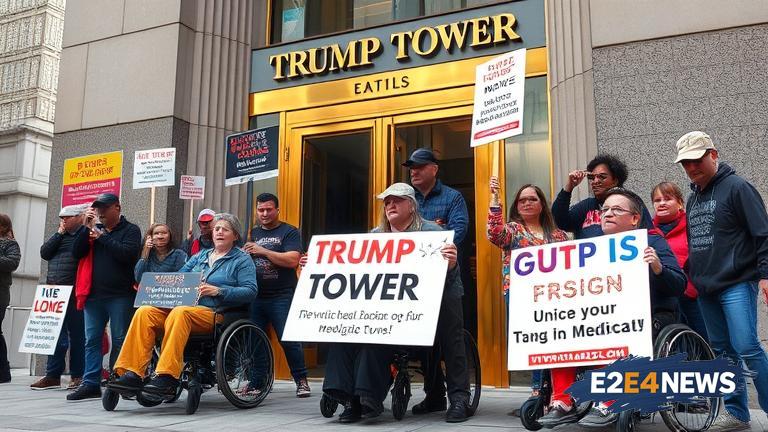A passionate group of disabled activists converged on Trump Tower in New York City to express their strong opposition to the proposed Medicaid cuts. The protesters, who were predominantly wheelchair users, employed a range of tactics to draw attention to their cause, including chanting slogans and holding placards. The demonstration was organized by a coalition of disability rights groups, who argue that the cuts would have a devastating impact on the lives of people with disabilities. The activists emphasized that Medicaid is a vital lifeline for many individuals with disabilities, providing them with essential healthcare services and support. Without Medicaid, many people with disabilities would be forced to rely on inadequate and unaffordable private healthcare options. The protesters also highlighted the importance of accessibility and inclusivity, stressing that people with disabilities have the right to participate fully in society. The demonstration was peaceful, but the activists were determined to make their voices heard. They called on the government to reconsider the proposed cuts and to prioritize the needs of people with disabilities. The protesters also emphasized the need for greater awareness and understanding of disability issues, arguing that people with disabilities are often marginalized and excluded from mainstream society. The demonstration at Trump Tower was just one of a series of protests and rallies that have taken place across the United States in recent weeks, as disability rights activists mobilize to defend their rights. The activists are determined to fight against the proposed Medicaid cuts, which they see as a threat to their very way of life. They argue that the cuts would not only harm people with disabilities but also have a negative impact on the broader community. The protesters also criticized the government for failing to consult with people with disabilities and their organizations, arguing that this lack of engagement has resulted in policies that are out of touch with the needs of people with disabilities. The demonstration at Trump Tower was attended by a range of prominent disability rights activists, who used the occasion to call for greater solidarity and unity among people with disabilities. They emphasized the importance of working together to achieve common goals and to challenge the systemic barriers that prevent people with disabilities from participating fully in society. The protesters also highlighted the need for greater representation and inclusion of people with disabilities in decision-making processes, arguing that this is essential for creating policies that are responsive to their needs. The demonstration was widely covered in the media, with many outlets highlighting the passion and determination of the protesters. The activists are hopeful that their message will resonate with the broader public and that the government will be forced to reconsider the proposed Medicaid cuts. The fight against the cuts is likely to be long and difficult, but the activists are undeterred, arguing that their cause is just and that they will continue to mobilize until their rights are respected. The protesters also emphasized the importance of intersectionality, arguing that disability rights are closely tied to other social justice issues, such as racism, sexism, and poverty. They called for a more nuanced understanding of the complex relationships between different forms of oppression and argued that a comprehensive approach is needed to address the needs of people with disabilities. The demonstration at Trump Tower was a powerful expression of the anger and frustration felt by many people with disabilities, who are tired of being marginalized and excluded from mainstream society. The activists are determined to challenge the status quo and to fight for a more just and inclusive society, where people with disabilities have equal rights and opportunities.
